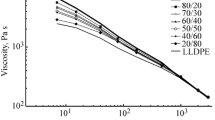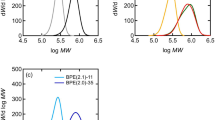Abstract
An important method of the modification of the properties of polyethylene and polypropylene is the copolymerisation with α-olefins. The α-olefin behaves as a short branch in the structure, and the rheological and thermal properties of copolymers change significantly. A new method is suggested to evaluate the rheological and thermal properties of copolymers on the basis of homopolymer properties, by introducing a short branch degree parameter. The zero shear viscosity, plateau modulus, fractional free volume, reptation tube diameter, glass transition temperature and thermodynamical melting point were calculated.










Similar content being viewed by others
References
Carreau P (1972) Rheological equation from molecular network theory. Trans Soc Rheol 16:1–99
Dealy JM, Wissbrun KF (1990) Melt rheology and its role in plastic processing. Van Nostrand Reinhold, New York, p 371
Dubek G, Bamford D, Rodriguez-Gonzales A, Bornemann S, Stejny J, Schade B, Alam MA, Arnold M (2001) Free volume, glass transition and degree of branching in metallocene based propylene-α-olefin copolymers, positron lifetime density and different scanning calorimetry studies. J Polym Sci Part B Polym Phys 40:434–453
Ferry JD (1980) Viscoelastic properties of polymers 3rd edn. p 376
Fetters LJ, Lohse DJ, Graessley WW (1999) Chain dimensions and entanglement spacings in dense macromolecular systems. J Polym Sci Part B Polym Phys 37:1023–1033
Halász L, Vorster O, Masalova I, Tincul I, Potgieter AH (1998a) Rheological properties of some new polypropylene copolymers PPS-14. In: 15th annual meeting of the Polymer Processing Society, Yokohama, 8–12 June, p 281
Halász L, Voster O, Belina K, Tincul I, Potgieter AH (1998b) Thermal and rheological properties of some new polypropylene copolymer, IUPAC Macro 98. In: World polymer conference, 12–18 July, Gold Coast, Australia, p 879
Halász L, Belina K, Vorster O, Tincul I (2003) The effect of comonomer content on the rheological properties of polyolefin copolymers. In: PPS Europa/Africa regional meeting, Athen, Sept 14–17, p 199
Hoffman JD, Weeks JJ (1962) J Res Natl Bur Stand (US) A66, 13
Tincul I, Potgieter AH (1996) Propylene/1-pentene random copolxymers, a new family of high performance polymers, Polypropylene 96. In: 5th annual world congress, Zürich, p IV.3
Tincul I, Joubert DJ, Potgieter AH (1999). “Propylene copolymers with linear Fischer–Tropsch derived α-olefins”, Polypropylene 99. In: 8th annual world congress, 14–16 September, Zürich, p IX.3
Wu S, Beckerbauer R (1992) Chain entanglement in homopolymer, copolymers and terpolymers of methylmetacrylates, styrene and N-phnylmaleimide. Polymer 33:509–515
Yasuda KY, Armstrong, RC, Cohen RC (1981) Shear flow properties of concentrated solutions of linear and star branched polystyrene. Rheol Acta 20:163
Author information
Authors and Affiliations
Corresponding author
Rights and permissions
About this article
Cite this article
Halász, L., Vorster, O. & Belina, K. The effect of short chain branching on the rheological and thermal properties of olefin: α-olefin copolymers. Rheol Acta 44, 427–433 (2005). https://doi.org/10.1007/s00397-004-0427-y
Received:
Accepted:
Published:
Issue Date:
DOI: https://doi.org/10.1007/s00397-004-0427-y




